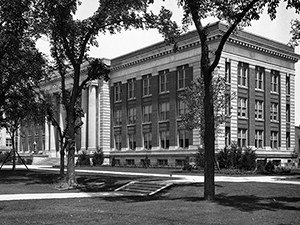Physics plans for Tate Lab renovation

Serving students, faculty, and researchers for more than 86 years, Tate Laboratory is in need of a renovation to remain competitive.
For 86 years, the John T. Tate Laboratory of Physics (Tate Laboratory) has been home to the University of Minnesota’s School of Physics and Astronomy, which offers the core courses required to prepare students for a wide range of careers in engineering and science. Each year, nearly 4,500 students from dozens of majors pass through the halls of Tate Laboratory to receive instruction in physics and astronomy.
“Nationwide, we’re among the top 10 universities in the number of freshman students we instruct,” said Ron Poling, professor and head of the School of Physics and Astronomy.
Given the number of students and faculty it supports, the current infrastructure of Tate Laboratory can no longer sustain today’s modern physics enterprise, which is vital to recruiting and retaining high quality faculty, and attracting support for cuttingedge research. The building is in need of a renovation, and one of seven investment projects on the University Board of Regents’ capital requests list.
Early beginnings of physics
The rich history of physics at the University of Minnesota dates back to 1889, when then University president Cyrus Northrop hired Frederick S. Jones, a young colleague from Yale, who became the first professor of physics and successfully taught for years. During Jones’ tenure, the first Physical Laboratory, now called Jones Hall, was completed in 1902. It was the first home of the physics department.
Changing needs and technological advances required a new facility be built 25 years later. In 1927, the front portion of Tate Laboratory was completed. Since then, the building has been expanded and remodeled nearly a half dozen times. The most recent major renovation was construction of the space physics laboratories in the south wing, almost 50 years ago. In 2012, Tate Laboratory was designated a Historic Site for Physics by the American Physical Society.
Cutting-edge research and accomplishments
Past activities of physicists from the University’s School of Physics and Astronomy have been foundational to today’s technology-intensive world. Known worldwide, they include Alfred Nier, who built a high-precision mass spectrometer that first separated the fissile isotope of uranium (U-235); Edward Ney, who pioneered the use of high altitude balloons for scientific investigations; John Williams, a nuclear physicist who worked on the Manhattan Project; John Tate, who worked tirelessly to elevate Minnesota’s ranks in the field of physics, and countless more.
Six former faculty and alumni physicists have received the Nobel Prize, more than any other school or department at the University. They are pioneers in studying nuclear energy, particle theory, neutrinos, and many areas of physics fundamental to groundbreaking discoveries.
“This will enable consolidation of programs in geology, geobiology, hydrogeology, geochemistry, and geophysics. Earth sciences and physics are closely related fields, and there are longstanding connections between the two disciplines at the University.”— Ron Poling
“Today’s experimentalists working in our labs in Tate do cutting-edge investigations of novel materials, study the physics of biological systems, and develop instrumentation used at dozens of the most advanced research facilities, some as near as northern Minnesota’s Soudan Underground Laboratory and others as far as the South Pole or orbiting the earth. Theoretical physicists work to interpret the latest experimental data to achieve deeper understanding of matter and energy in all of their forms and of the structure and evolution of the Universe,” Poling said. “Students benefit by working side-byside with these faculty on research projects.”
Plans for the future
With a building designed more than 80 years ago, physics at the University of Minnesota has been at a major disadvantage. “The basic mechanicals are a mess—bad roof, not energy efficient, and no central climate control. The building is inadequate for today’s research needs,” Poling said.
“Preliminary planning is currently underway,” Poling said. “Initial funding for the project will be sought by the University of Minnesota during the 2014 Minnesota Legislative session.”
When completed, the building will house the School of Physics and Astronomy and the Department of Earth Sciences, currently located in Pillsbury Hall.
“This will enable consolidation of programs in geology, geobiology, hydrogeology, geochemistry, and geophysics,” Poling said. “Earth sciences and physics are closely related fields, and there are longstanding connections between the two disciplines at the University.”
Plans call for a full gut of Tate Laboratory, which could start within a few years. To maintain the historical nature of the University’s main campus mall, the front of Tate Laboratory will be preserved.
Three designs are being considered. “One major component—the tank on the south side of the building that once housed a particle accelerator for nuclear physics research will be removed,” Poling said. “Currently, there’s no entrance on Church Street, and we would like it to connect to the mall. Many of our aspirations will depend on the final funding.”
In addition to updated offices, conference rooms, seminar and lecture spaces for faculty, students will benefit from high-tech spaces similar to the Science Teaching and Student Services Building, which opened in 2010. The concept is to provide new opportunities for learning and collaborating with peers, not just in classes and laboratories, but also in informal interactions and organized student group activities.
“Active learning and cooperative groups have been part of our teaching program for many years and have proven themselves with improved student achievement. Now we look forward to having facilities that will better support these innovations,” Poling said.
“We’re competing for the best and brightest students and retaining world-class faculty. This proposed renovation will increase our odds of that happening,” Poling added.
